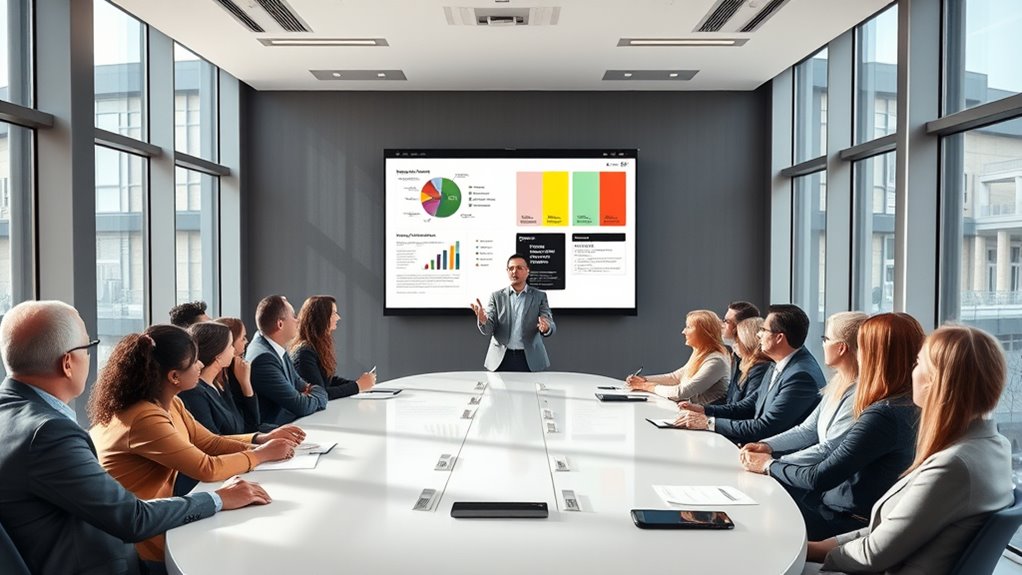To run an effective all-hands meeting, start by setting clear objectives and crafting a focused agenda. Choose the best time and format—virtual, in-person, or hybrid—that encourages participation. Share pre-meeting materials and include interactive elements like polls or breakout sessions to boost engagement. Communicate openly, invite feedback, and use reliable technology to support smooth delivery. For in-depth tips that guarantee your meeting’s success, keep exploring the key strategies involved.
Key Takeaways
- Define clear objectives, agenda, and desired outcomes to guide the meeting effectively.
- Choose an appropriate format and timing to maximize participation and engagement.
- Incorporate interactive elements like polls, breakout sessions, and Q&A to foster involvement.
- Prepare and share pre-meeting materials and relevant documents in advance for clarity.
- Follow up with action items, gather feedback, and continuously improve future all-hands meetings.
Define Clear Objectives and Agenda

Why is it important to start with clear objectives and a well-defined agenda? Because they set the tone and keep everyone focused. When you outline specific goals, you guide your team’s attention and ensure the meeting stays productive. Use visual presentation techniques to highlight key points, making the agenda engaging and easy to follow. If your meeting includes virtual breakout sessions, clearly specify their purpose and outcomes in advance, so participants are prepared to contribute meaningfully. A detailed agenda helps prevent tangents and keeps the discussion aligned with your objectives. This clarity boosts engagement, minimizes confusion, and ensures your all-hands meeting delivers value for everyone involved. Incorporating data-driven strategies into your planning can further enhance the focus and effectiveness of your meeting. Additionally, understanding your audience preferences and expectations can help tailor the content, increasing engagement and participation.
Choose the Right Time and Format

After setting clear objectives and a detailed agenda, the next step is to choose the most effective time and format for your all-hands meeting. Timing considerations are essential; schedule it when most team members can participate fully, avoiding busy periods or deadlines. Consider whether to hold the meeting during regular work hours or at a different time to maximize attendance and engagement. When selecting format options, think about whether a virtual, in-person, or hybrid approach best suits your team’s needs. Virtual meetings offer flexibility, while in-person sessions foster connection. Hybrid formats can combine both, but require careful planning. The goal is to create an environment that encourages open communication, active participation, and alignment, ensuring the meeting’s objectives are achieved effectively. Choosing the right meeting environment can significantly impact your team’s comfort and productivity. Incorporating dynamic communication exercises can further enhance engagement and understanding during the session. Additionally, considering tuning techniques such as engaging visuals or interactive segments can help maintain energy levels and focus throughout the meeting. Being aware of projector technology and its capabilities can also improve the overall presentation quality, ensuring your message resonates. It’s also important to be mindful of Timing considerations to ensure maximum attendance and participation.
Prepare and Distribute Pre-Meeting Materials

To guarantee your all-hands meeting runs smoothly, you need to prepare and share clear pre-meeting materials. Make sure everyone understands the meeting goals, has access to relevant documents, and knows if they need to complete any pre-work. Doing this sets expectations and helps your team come prepared to contribute effectively. Additionally, providing information on best practices for effective meetings can improve engagement and productivity. Incorporating clear communication strategies ensures that your message is understood and that participants stay focused on the agenda. Consider aligning your meeting content with a cohesive theme to reinforce key messages and create a more impactful session. Employing data-driven strategies in your planning can further enhance the relevance and success of your meeting outcomes. Using appropriate cookie management tools can also support transparency and trust with your team during the planning process.
Clarify Meeting Goals
Preparing and distributing pre-meeting materials is essential to guarantee everyone is aligned on the meeting’s goals. By clearly communicating the meeting purpose upfront, you help set expectations and foster goal alignment among participants. When you share relevant documents and outline the key topics beforehand, attendees come prepared to contribute meaningfully. This clarity ensures that discussions stay focused and productive, avoiding tangents or confusion. Make sure your materials explicitly state the objectives and desired outcomes, so everyone understands what you aim to accomplish. Additionally, incorporating insights from imaginative play can help inform how you frame the meeting’s goals to encourage creativity and engagement. As a result, your all-hands meeting becomes more efficient, with participants ready to engage around shared goals and priorities. Clear pre-meeting communication builds a strong foundation for a successful, goal-oriented session.
Share Relevant Documents
How can you guarantee everyone is on the same page before the meeting? Sharing relevant documents ahead of time is key. Distribute clear, concise materials like agendas, reports, or visual aids to help attendees prepare. Use handouts or digital files to emphasize important points and ensure engagement. Consider including charts or graphs to clarify complex data. To make this easier, create a shared folder or email the documents well in advance. Here’s a quick overview:
| Document Type | Purpose | Format |
|---|---|---|
| Agenda | Outline meeting flow | PDF or Word |
| Reports | Provide updates and data | PDF, Excel |
| Visual Aids | Clarify key points | PowerPoint, PDFs |
| Handouts | Reinforce discussion topics | Printed or digital |
Providing these materials guarantees everyone arrives prepared and aligned. Additionally, ensuring that all participants understand the legal processes involved can help facilitate smoother discussions. Incorporating effective communication skills when presenting these materials can further enhance understanding and engagement. Furthermore, understanding the butter composition can help illustrate complex data more clearly when needed. Being aware of angel number symbolism can also provide additional context to interpret messages or signs related to relationships discussed during the meeting. To further improve preparation, including a collaboration platform can streamline document sharing and real-time discussions.
Assign Pre-Work Tasks
Once you’ve shared the relevant documents ahead of time, the next step is to assign pre-work tasks. Clearly outline what team members need to review or prepare before the meeting, ensuring everyone understands their responsibilities. This pre-work promotes team building by encouraging collaboration and accountability. It also helps reinforce cultural alignment, emphasizing shared goals and values. Assign specific tasks, such as analyzing data or preparing updates, and specify deadlines to keep momentum. Use your communication channels effectively to distribute these tasks, making sure they’re accessible and easy to understand. When everyone completes their pre-work, the meeting runs more smoothly, fostering a cohesive environment where team building and cultural alignment are prioritized from the start. Regularly reviewing QA best practices can further enhance the effectiveness of your preparation and overall meeting outcomes.
Engage Participants With Interactive Elements
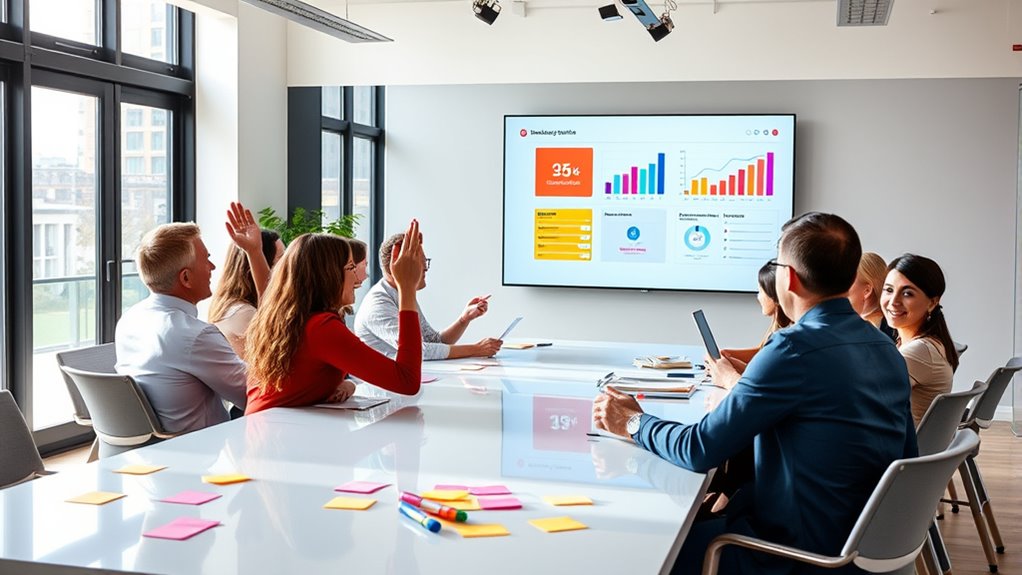
Ever wondered how to make your all-hands meetings more lively and memorable? The key is incorporating interactive elements that boost engagement. Here are three effective methods:
- Use virtual breakout sessions to facilitate small-group discussions, making participants feel more involved.
- Incorporate live polls throughout the meeting to gather instant feedback and spark participation.
- Add interactive Q&A segments where attendees can ask questions or share ideas in real-time.
- Highlight the benefits of jet boats for an exciting team-building activity, such as a boat tour or water sports event, to energize the group further. Integrating interactive tools can also enhance the overall experience and foster a collaborative atmosphere. Understanding the importance of family dynamics in personal stories can inspire more authentic engagement during team activities.
These techniques encourage active participation, break down barriers, and keep energy levels high. Virtual breakout sessions allow for meaningful conversations, while live polls provide immediate insights. Combining these elements transforms a passive meeting into an engaging experience that keeps everyone connected and invested.
Communicate Transparently and Encourage Feedback

Transparent communication lays the foundation for trust and accountability in your all-hands meetings. To foster openness and honesty, share updates honestly and admit uncertainties when necessary. Encourage active listening by creating space for team members to voice concerns without interruption. Respond thoughtfully, showing that their feedback matters. Use this table to visualize key strategies:
| Openness & Honesty | Active Listening | Encouraging Feedback |
|---|---|---|
| Share honest updates | Listen without interrupting | Ask open-ended questions |
| Admit uncertainties | Clarify understanding | Act on suggestions |
| Be transparent about challenges | Reflect their points | Celebrate contributions |
Utilize Technology Effectively
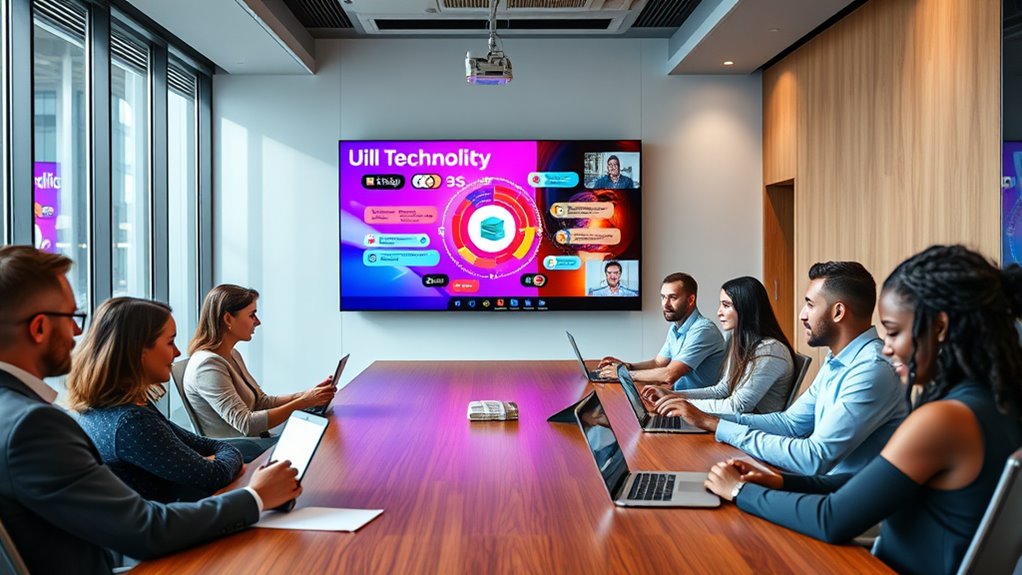
To run an effective all-hands meeting, you need to choose the right tools that fit your team’s needs. Make sure everyone has reliable connectivity so the meeting runs smoothly without interruptions. When technology works seamlessly, your team can focus on engaging and meaningful discussions.
Choose the Right Tools
Choosing the right tools is essential for running an effective all-hands meeting, especially when you want to keep everyone engaged and on the same page. The technology you select can make or break the experience. Focus on tools that support digital collaboration and facilitate smooth communication. For instance, consider platforms with virtual breakout rooms to encourage small group discussions. Here are some top choices:
- Video conferencing tools with reliable streaming and screen sharing.
- Digital collaboration platforms that allow real-time document editing.
- Features for virtual breakout sessions to foster interaction and ideas sharing.
Using these tools ensures your meeting stays dynamic, interactive, and productive, even in a remote setting. The right technology helps everyone participate fully and stay connected throughout the session.
Ensure Clear Connectivity
Once you’ve selected the right tools for your all-hands meeting, guaranteeing everyone has a stable and clear connection becomes the next priority. Good connectivity prevents disruptions and maximizes engagement, creating better networking opportunities and fostering team bonding. Test the technology beforehand to identify potential issues. Provide clear instructions to participants on how to troubleshoot common problems. Use platforms with reliable audio and video quality, and consider backup options like dial-in numbers.
| Technology Aspect | Best Practices |
|---|---|
| Internet Connection | Recommend wired connections for stability |
| Video Platform | Choose user-friendly, high-quality tools |
| Audio Quality | Use headsets or microphones for clarity |
| Screen Sharing | Ensure smooth presentations with minimal lag |
| Backup Plans | Have alternative methods ready in case of tech failure |
Follow Up and Track Action Items
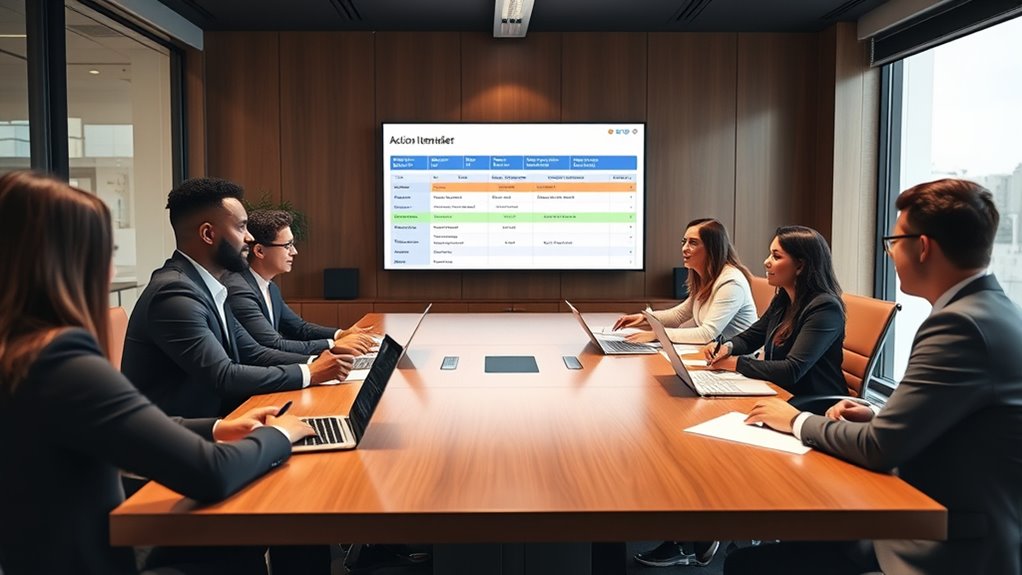
Effective follow-up and tracking of action items guarantee your team stays on course after the meeting. To make certain action item accountability, implement clear follow-up strategies, so responsibilities are understood and deadlines are met. Here are three key tips:
- Assign specific owners to each action item, ensuring everyone knows their role.
- Use a shared tracking tool to monitor progress and update statuses regularly.
- Schedule brief check-ins to review progress and address obstacles promptly.
Evaluate the Meeting’s Success and Improve
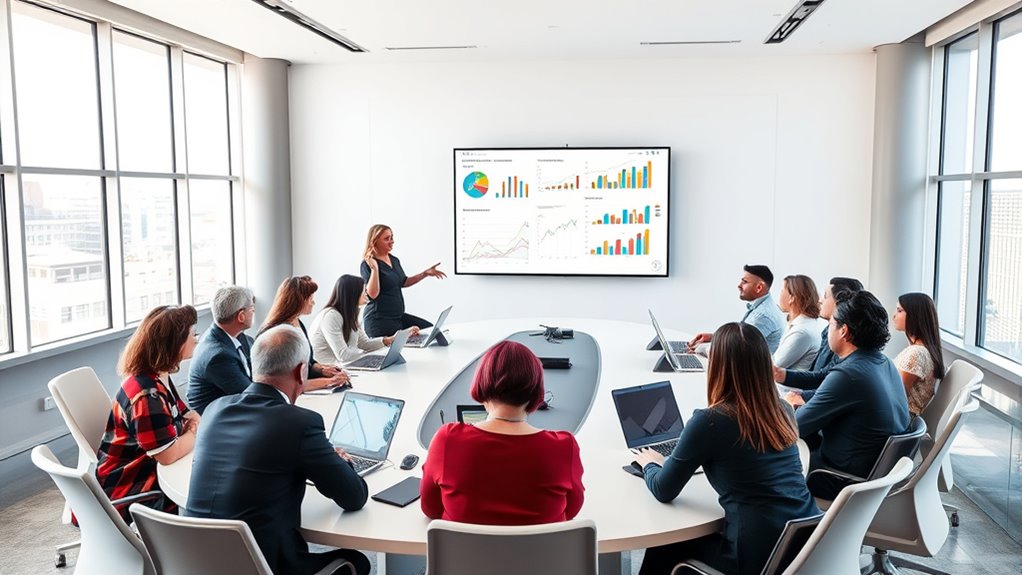
After following up on action items and tracking progress, it’s time to assess whether your meeting achieved its goals. To do this, start by measuring engagement—did attendees participate actively and ask questions? This helps you gauge overall involvement. Gathering feedback is equally important; ask participants what worked well and what could improve. Use surveys or quick polls to collect honest insights, which reveal whether your goals were met and highlight areas for enhancement. Analyzing these responses allows you to identify patterns and adjust your approach for future meetings. Continuously evaluating the effectiveness of your all-hands meetings ensures they remain valuable, engaging, and aligned with your team’s needs. This iterative process fosters a culture of improvement and open communication.
Frequently Asked Questions
How Can I Ensure Remote Participants Feel Included?
To make remote participants feel included, start with virtual icebreakers that encourage everyone to share. Use inclusive language throughout the meeting, addressing all voices equally. Make sure your technology works smoothly so no one gets left out. Encourage questions and comments from remote team members, and consider using breakout rooms for smaller discussions. By actively engaging everyone and fostering a welcoming environment, you create a sense of belonging for all participants.
What Are Common Pitfalls to Avoid During All-Hands Meetings?
Like a ship lost at sea, you must avoid common pitfalls such as neglecting timing consistency and unclear agendas. Failing to stick to scheduled times frustrates attendees, while vague agendas cause confusion and disengagement. Keep the meeting focused and well-structured, ensuring everyone understands the purpose. By maintaining timing discipline and agenda clarity, you steer your all-hands meeting smoothly, fostering engagement and productivity across your team.
How Long Should an Effective All-Hands Meeting Last?
An effective all-hands meeting should last about 60 to 90 minutes. Keep your meeting agenda focused on key updates and avoid lengthy presentations; aim for each presentation duration of 10-15 minutes. By staying within this timeframe, you maintain engagement and guarantee your team stays attentive. Remember, a concise agenda with clear goals helps prevent fatigue and keeps everyone motivated to participate actively.
How Do I Handle Difficult Questions or Conflicts?
Remember, a problem shared is a problem halved. When handling criticism or managing disagreements, stay calm and listen actively. Acknowledge concerns without becoming defensive, and clarify points when needed. Address difficult questions transparently, focusing on solutions rather than blame. By maintaining professionalism and fostering open dialogue, you turn conflicts into opportunities for growth, ensuring your all-hands meeting remains productive and respectful even during tough conversations.
What Tools Are Best for Virtual All-Hands Meetings?
For virtual all-hands meetings, use tools like Zoom or Microsoft Teams for seamless virtual collaboration. These platforms offer features like breakout rooms and live chat to boost engagement strategies. You can also incorporate tools like Slido or Mentimeter to facilitate real-time polls and Q&A sessions, making your team feel involved and connected. Choose user-friendly options that support interaction, ensuring your virtual meeting is dynamic and effective.
Conclusion
Now that you’ve mastered the art of the all-hands meeting, remember it’s like herding cats with a laser pointer—keep everyone focused, engaged, and moving in the same direction. Use tech wisely, be transparent, and follow up like a boss. After all, if your meeting’s a circus, at least make sure the elephants don’t forget their trunks. Nail it, and your team will leave wondering if they just attended a meeting or a motivational rally.
